Abstract
The substrate preference of recombinant Escherichia coli thymidylate synthase (TS) has been altered from 2'-deoxyuridylate (dUMP) to 2'-deoxycytidylate (dCMP) by site-directed mutagenesis of the codon for Asn177, which was changed to aspartic acid. The side-chain amide of Asn177 forms hydrogen bonds with O4 and N3 of dUMP bound to the crystalline enzyme [Montfort, W. R., Perry, K. M., Fauman, E. B., Finer-Moore, J. S., Maley, G. F., Hardy, L., Maley, F. & Stroud, R. M. (1990) Biochemistry 29, 6964-6977]. This Asn is invariant in all natural sequences for TS known. The values of kcat for the mutant enzyme, TS(N177D), with dCMP and dUMP are, respectively, 0.09 and 0.002 times the value of kcat of wild-type TS with dUMP as substrate. TS(N177D) turns over dCMP at 35 times its rate of dUMP turnover, whereas wild-type TS turns over dCMP at < 10(-5) of its rate of dUMP turnover. Thus Asn177 is a major determinant of the pyrimidine nucleotide specificity of TS. The mutant enzyme, like wild-type TS, forms a covalent complex with 5-fluoro-dUMP in the presence of 5,10-methylenetetrahydrofolate. TS(N177D) also has a newly acquired ability to be transiently inactivated by dUMP. This time-dependent inactivation requires the presence of methylenetetrahydrofolate and may be due to the accumulation of the enzyme in the form of a catalytic intermediate. The likely mechanistic basis for discrimination by TS between dUMP and dCMP is their differing requirements for charge stabilization during covalent catalysis.
Full text
PDF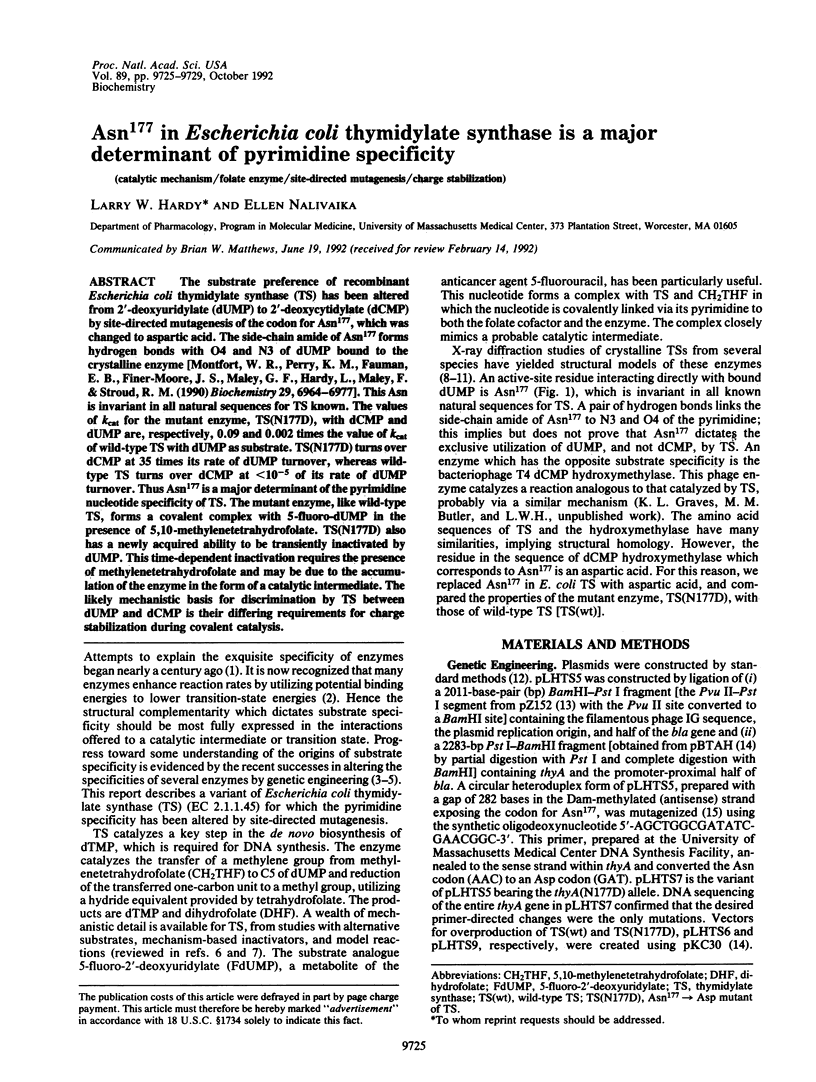
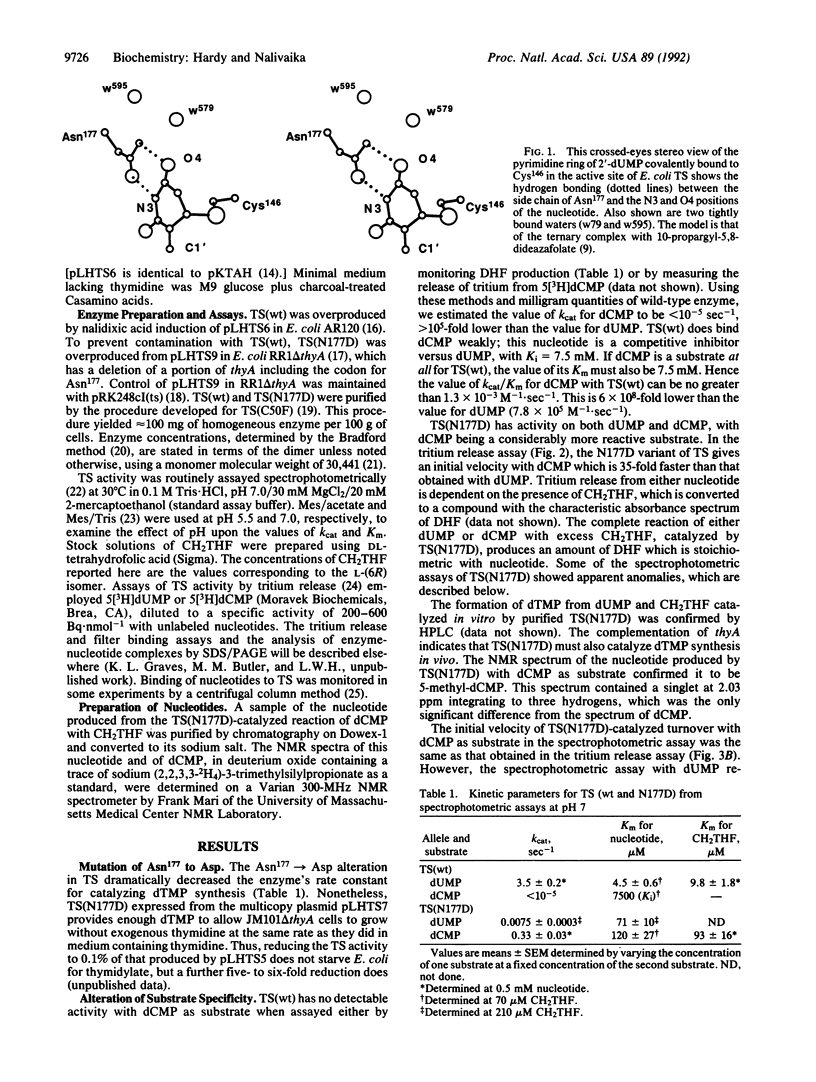
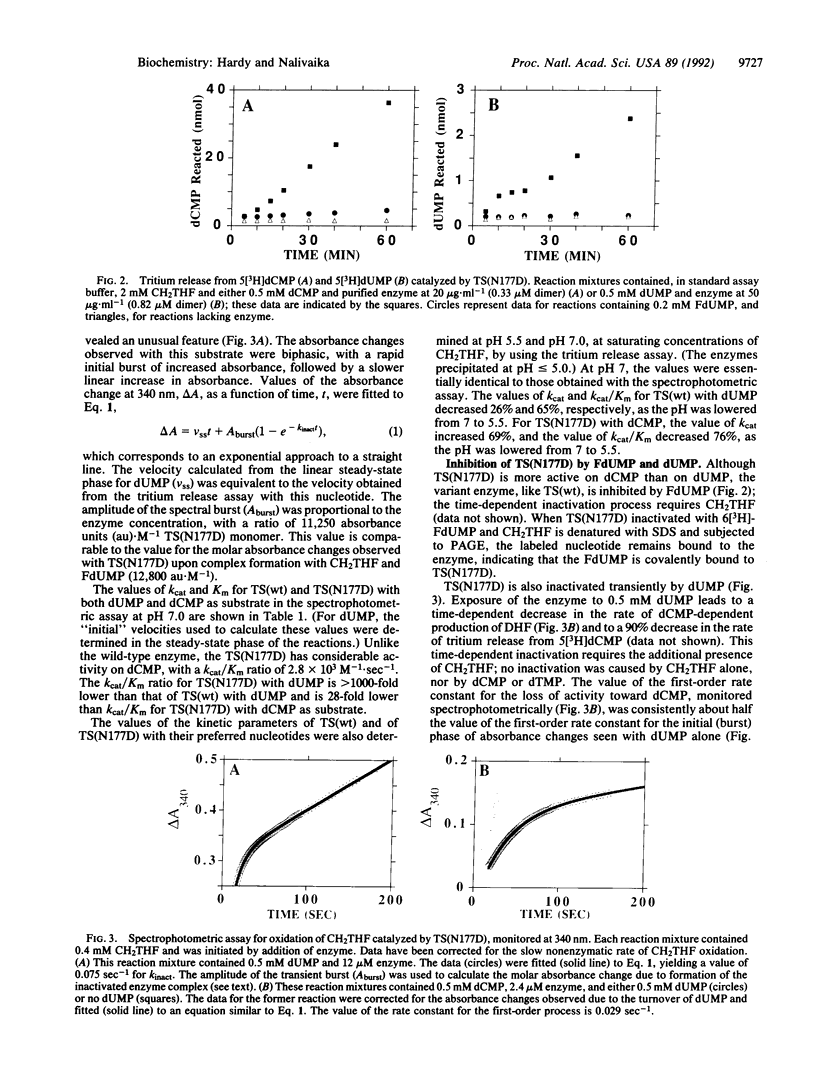
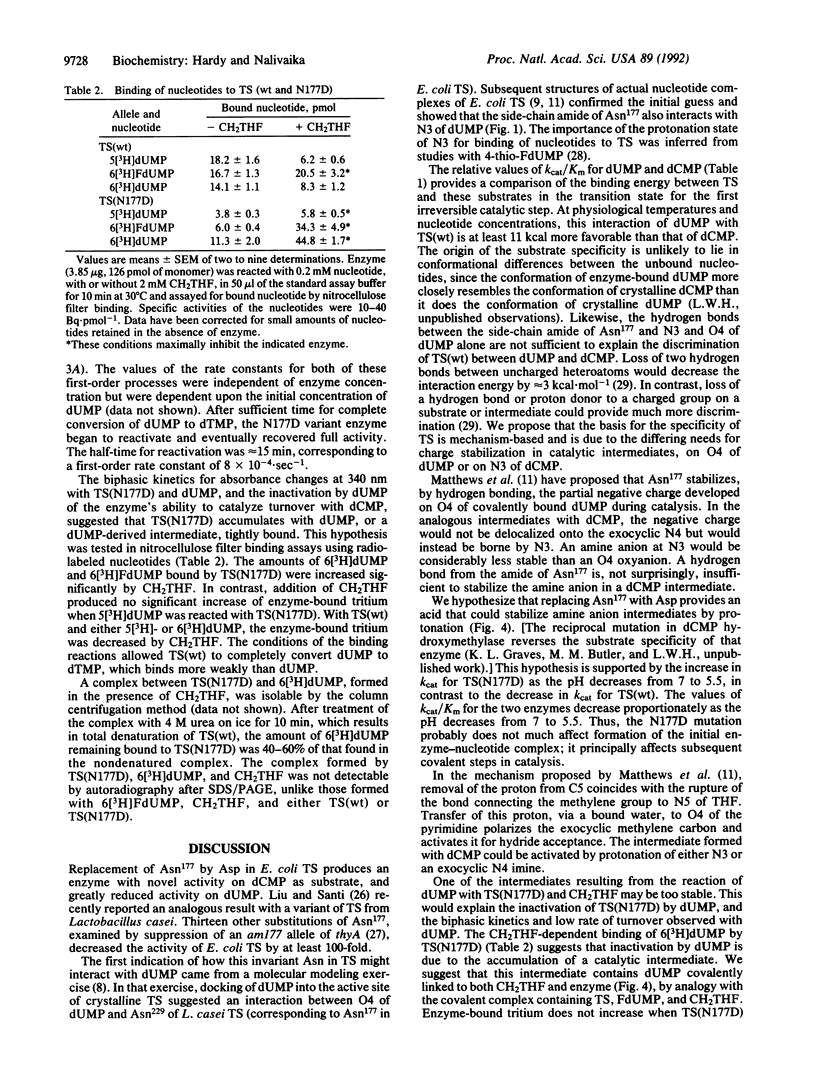
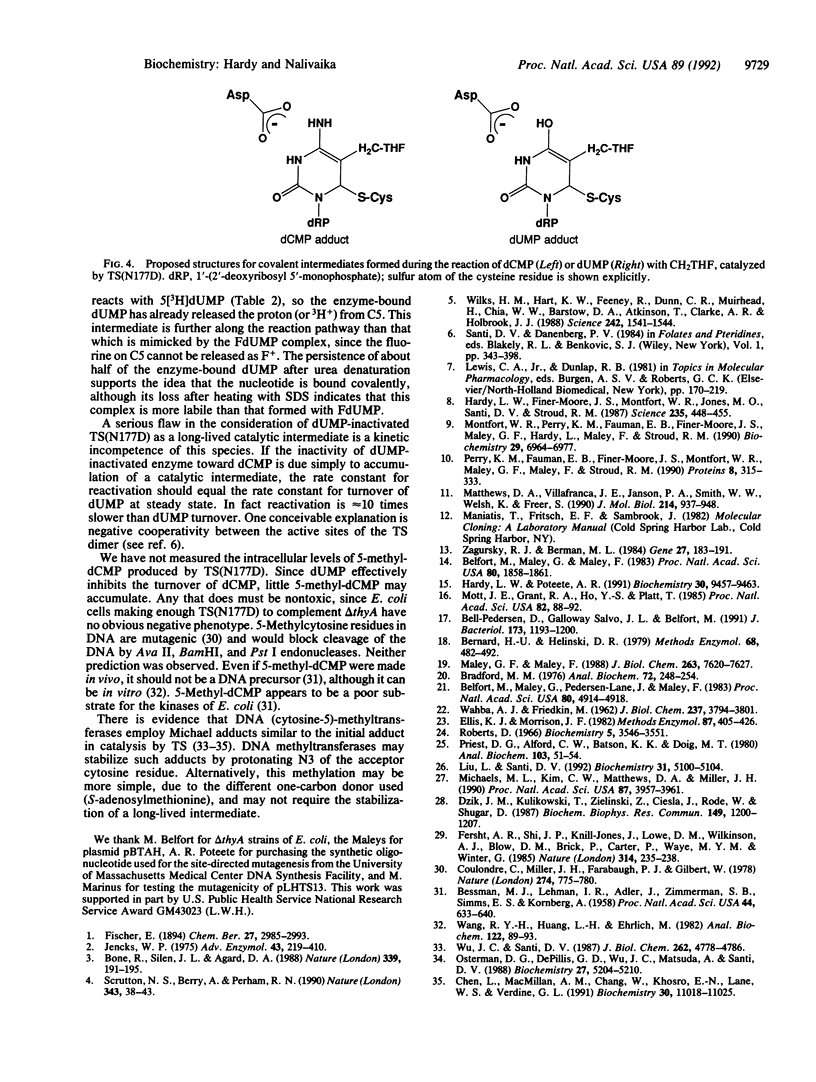
Images in this article
Selected References
These references are in PubMed. This may not be the complete list of references from this article.
- Belfort M., Maley G. F., Maley F. Characterization of the Escherichia coli thyA gene and its amplified thymidylate synthetase product. Proc Natl Acad Sci U S A. 1983 Apr;80(7):1858–1861. doi: 10.1073/pnas.80.7.1858. [DOI] [PMC free article] [PubMed] [Google Scholar]
- Belfort M., Maley G., Pedersen-Lane J., Maley F. Primary structure of the Escherichia coli thyA gene and its thymidylate synthase product. Proc Natl Acad Sci U S A. 1983 Aug;80(16):4914–4918. doi: 10.1073/pnas.80.16.4914. [DOI] [PMC free article] [PubMed] [Google Scholar]
- Bell-Pedersen D., Galloway Salvo J. L., Belfort M. A transcription terminator in the thymidylate synthase (thyA) structural gene of Escherichia coli and construction of a viable thyA::Kmr deletion. J Bacteriol. 1991 Feb;173(3):1193–1200. doi: 10.1128/jb.173.3.1193-1200.1991. [DOI] [PMC free article] [PubMed] [Google Scholar]
- Bernard H. U., Helinski D. R. Use of the lambda phage promoter PL to promote gene expression in hybrid plasmid cloning vehicles. Methods Enzymol. 1979;68:482–492. doi: 10.1016/0076-6879(79)68037-0. [DOI] [PubMed] [Google Scholar]
- Bessman M. J., Lehman I. R., Adler J., Zimmerman S. B., Simms E. S., Kornberg A. ENZYMATIC SYNTHESIS OF DEOXYRIBONUCLEIC ACID. III. THE INCORPORATION OF PYRIMIDINE AND PURINE ANALOGUES INTO DEOXYRIBONUCLEIC ACID. Proc Natl Acad Sci U S A. 1958 Jul 15;44(7):633–640. doi: 10.1073/pnas.44.7.633. [DOI] [PMC free article] [PubMed] [Google Scholar]
- Bone R., Silen J. L., Agard D. A. Structural plasticity broadens the specificity of an engineered protease. Nature. 1989 May 18;339(6221):191–195. doi: 10.1038/339191a0. [DOI] [PubMed] [Google Scholar]
- Bradford M. M. A rapid and sensitive method for the quantitation of microgram quantities of protein utilizing the principle of protein-dye binding. Anal Biochem. 1976 May 7;72:248–254. doi: 10.1006/abio.1976.9999. [DOI] [PubMed] [Google Scholar]
- Chen L., MacMillan A. M., Chang W., Ezaz-Nikpay K., Lane W. S., Verdine G. L. Direct identification of the active-site nucleophile in a DNA (cytosine-5)-methyltransferase. Biochemistry. 1991 Nov 19;30(46):11018–11025. doi: 10.1021/bi00110a002. [DOI] [PubMed] [Google Scholar]
- Coulondre C., Miller J. H., Farabaugh P. J., Gilbert W. Molecular basis of base substitution hotspots in Escherichia coli. Nature. 1978 Aug 24;274(5673):775–780. doi: 10.1038/274775a0. [DOI] [PubMed] [Google Scholar]
- Dzik J. M., Kulikowski T., Zielinski Z., Ciesla J., Rode W., Shugar D. Interaction of 5-fluoro-4-thio-2'-deoxyuridine 5'-phosphate with mammalian tumour thymidylate synthase: role of the pyrimidine N(3)-H dissociation. Biochem Biophys Res Commun. 1987 Dec 31;149(3):1200–1207. doi: 10.1016/0006-291x(87)90535-3. [DOI] [PubMed] [Google Scholar]
- Ellis K. J., Morrison J. F. Buffers of constant ionic strength for studying pH-dependent processes. Methods Enzymol. 1982;87:405–426. doi: 10.1016/s0076-6879(82)87025-0. [DOI] [PubMed] [Google Scholar]
- Fersht A. R., Shi J. P., Knill-Jones J., Lowe D. M., Wilkinson A. J., Blow D. M., Brick P., Carter P., Waye M. M., Winter G. Hydrogen bonding and biological specificity analysed by protein engineering. Nature. 1985 Mar 21;314(6008):235–238. doi: 10.1038/314235a0. [DOI] [PubMed] [Google Scholar]
- Hardy L. W., Finer-Moore J. S., Montfort W. R., Jones M. O., Santi D. V., Stroud R. M. Atomic structure of thymidylate synthase: target for rational drug design. Science. 1987 Jan 23;235(4787):448–455. doi: 10.1126/science.3099389. [DOI] [PubMed] [Google Scholar]
- Hardy L. W., Poteete A. R. Reexamination of the role of Asp20 in catalysis by bacteriophage T4 lysozyme. Biochemistry. 1991 Oct 1;30(39):9457–9463. doi: 10.1021/bi00103a010. [DOI] [PubMed] [Google Scholar]
- Jencks W. P. Binding energy, specificity, and enzymic catalysis: the circe effect. Adv Enzymol Relat Areas Mol Biol. 1975;43:219–410. doi: 10.1002/9780470122884.ch4. [DOI] [PubMed] [Google Scholar]
- Liu L., Santi D. V. Mutation of asparagine 229 to aspartate in thymidylate synthase converts the enzyme to a deoxycytidylate methylase. Biochemistry. 1992 Jun 9;31(22):5100–5104. doi: 10.1021/bi00137a002. [DOI] [PubMed] [Google Scholar]
- Maley G. F., Maley F. Properties of a defined mutant of Escherichia coli thymidylate synthase. J Biol Chem. 1988 Jun 5;263(16):7620–7627. [PubMed] [Google Scholar]
- Matthews D. A., Villafranca J. E., Janson C. A., Smith W. W., Welsh K., Freer S. Stereochemical mechanism of action for thymidylate synthase based on the X-ray structure of the covalent inhibitory ternary complex with 5-fluoro-2'-deoxyuridylate and 5,10-methylenetetrahydrofolate. J Mol Biol. 1990 Aug 20;214(4):937–948. doi: 10.1016/0022-2836(90)90347-O. [DOI] [PubMed] [Google Scholar]
- Michaels M. L., Kim C. W., Matthews D. A., Miller J. H. Escherichia coli thymidylate synthase: amino acid substitutions by suppression of amber nonsense mutations. Proc Natl Acad Sci U S A. 1990 May;87(10):3957–3961. doi: 10.1073/pnas.87.10.3957. [DOI] [PMC free article] [PubMed] [Google Scholar]
- Montfort W. R., Perry K. M., Fauman E. B., Finer-Moore J. S., Maley G. F., Hardy L., Maley F., Stroud R. M. Structure, multiple site binding, and segmental accommodation in thymidylate synthase on binding dUMP and an anti-folate. Biochemistry. 1990 Jul 31;29(30):6964–6977. doi: 10.1021/bi00482a004. [DOI] [PubMed] [Google Scholar]
- Mott J. E., Grant R. A., Ho Y. S., Platt T. Maximizing gene expression from plasmid vectors containing the lambda PL promoter: strategies for overproducing transcription termination factor rho. Proc Natl Acad Sci U S A. 1985 Jan;82(1):88–92. doi: 10.1073/pnas.82.1.88. [DOI] [PMC free article] [PubMed] [Google Scholar]
- Osterman D. G., DePillis G. D., Wu J. C., Matsuda A., Santi D. V. 5-Fluorocytosine in DNA is a mechanism-based inhibitor of HhaI methylase. Biochemistry. 1988 Jul 12;27(14):5204–5210. doi: 10.1021/bi00414a039. [DOI] [PubMed] [Google Scholar]
- Perry K. M., Fauman E. B., Finer-Moore J. S., Montfort W. R., Maley G. F., Maley F., Stroud R. M. Plastic adaptation toward mutations in proteins: structural comparison of thymidylate synthases. Proteins. 1990;8(4):315–333. doi: 10.1002/prot.340080406. [DOI] [PubMed] [Google Scholar]
- Priest D. G., Alford C. W., Batson K. K., Doig M. T. A centrifugal column assay for thymidylate synthetase using the active site titrant 5-fluoro-2'-deoxyuridylate. Anal Biochem. 1980 Mar 15;103(1):51–54. doi: 10.1016/0003-2697(80)90234-1. [DOI] [PubMed] [Google Scholar]
- Roberts D. An isotopic assay for thymidylate synthetase. Biochemistry. 1966 Nov;5(11):3546–3548. doi: 10.1021/bi00875a022. [DOI] [PubMed] [Google Scholar]
- Scrutton N. S., Berry A., Perham R. N. Redesign of the coenzyme specificity of a dehydrogenase by protein engineering. Nature. 1990 Jan 4;343(6253):38–43. doi: 10.1038/343038a0. [DOI] [PubMed] [Google Scholar]
- WAHBA A. J., FRIEDKIN M. The enzymatic synthesis of thymidylate. I. Early steps in the purification of thymidylate synthetase of Escherichia coli. J Biol Chem. 1962 Dec;237:3794–3801. [PubMed] [Google Scholar]
- Wang R. Y., Huang L. H., Ehrlich M. Enzymatic conversion of deoxycytidine 5'-monophosphate to 5-methyldeoxycytidine 5'-triphosphate. Anal Biochem. 1982 May 1;122(1):89–93. doi: 10.1016/0003-2697(82)90255-x. [DOI] [PubMed] [Google Scholar]
- Wilks H. M., Hart K. W., Feeney R., Dunn C. R., Muirhead H., Chia W. N., Barstow D. A., Atkinson T., Clarke A. R., Holbrook J. J. A specific, highly active malate dehydrogenase by redesign of a lactate dehydrogenase framework. Science. 1988 Dec 16;242(4885):1541–1544. doi: 10.1126/science.3201242. [DOI] [PubMed] [Google Scholar]
- Wu J. C., Santi D. V. Kinetic and catalytic mechanism of HhaI methyltransferase. J Biol Chem. 1987 Apr 5;262(10):4778–4786. [PubMed] [Google Scholar]
- Zagursky R. J., Berman M. L. Cloning vectors that yield high levels of single-stranded DNA for rapid DNA sequencing. Gene. 1984 Feb;27(2):183–191. doi: 10.1016/0378-1119(84)90139-2. [DOI] [PubMed] [Google Scholar]



